GUJARAT STATE
Gurjarat (pop 61 million), originally settled 4000 years ago, went through the usual Buddhist, Hindu, Muslim and British conquerors. It is slightly off the tourist trail and alcohol is illegal here.
From Aurangabad, it was a tortuous 11 hour bus ride in a sleeper bed made for somebody 5′ 6″. With my first case of “tourista”, the incredibly rough roads raised havoc. I had to stop the bus a few times with diarrhea and had steady nausea – nice. I’m not sure if I slept at all. The bus arrived at Vadodara (pop 1.5 million) at 5 AM and I caught a bus 47 km north to see the Unesco Heritage Site of Champaner and Pavagadh.
The citadel is the heart of Champaner enclosed in a high stone wall. It’s most stunning features are its many mosques with elaborate carving, domes and minarets.
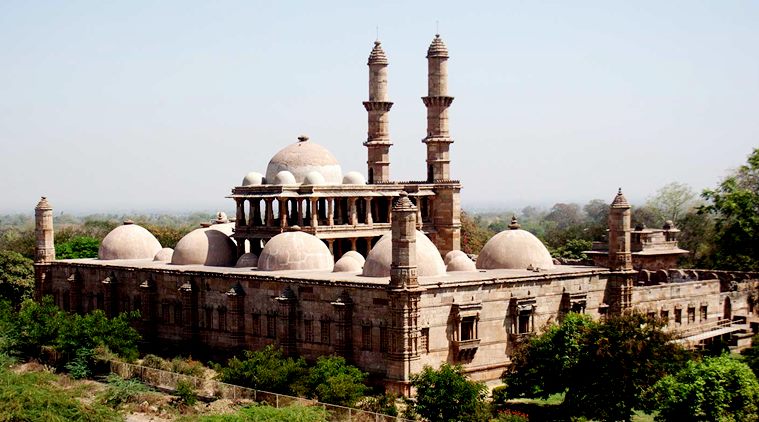
Pavagadh is a sacred, 762 m high volcanic hill with temples on top visited by Hindus and Jains. A bus goes half way up and a rope cable car takes you close to the summit and great views.
At the end of the day, it was a 2 hour bus ride to Ahmedabad (pop. 4.6 million), Gujarat’s major metropolis. The old world charm is, like so much of India, swamped by all the traffic, crowding, noise especially from vehicle horns, pollution, bad smells, cow shit, endless garbage, and the extremes of wealth and poverty. After 2 1/2 months in India, it can get exhausting. This is especially as in trying to see the majority of the sites, I tend to get off the tourist trail, and may go days without seeing a westerner. Indians are generally kind and try to be helpful, but there are an awful lot of them, all the same colour. 1.2 billion people easily outnumber us, even as tourists, as many Indians travel. We stand out like sore thumbs with our fair skin and hair. Most Indians seem fascinated by us, and it can be an endless interaction with them, especially children and young men. One is constantly approached – “which country?”, or “where coming from?”, “what your name?” and many want to shake your hand and take photographs posing with you. You can only imagine what it was like for a 6′ 8″ American I met in south India. Being extremely friendly and a pretty young woman can turn into hours of picture-taking. They wonder why you are travelling alone and where your wife is (and have difficulty relating to divorce). “Don’t you have any friends?” They want to know your profession, if you are a Christian, or if you like India (which they all seem to believe is the best country in the world).
Along with the crush of people and animals (cows, goats, street dogs, donkeys, monkeys), it is easy to see why India can become overwhelming. One either hates it or loves it. I’m somewhere in between. Most have poor English and conversations peter out rapidly, except in big cities, places on the tourist trail and some of the major IT cities with large populations of educated young people who often need English at work. The general filth gets disheartening. Now four months on the road, I guess I am getting a little homesick. My itinerary is to finish seeing India by mid March, spend 2 weeks in Sri Lanka, 1 week in the Maldives, 1 week in Bhutan and then finish off with Thailand before flying home at the end of April.
The old city of Ahmedabad used to be surrounded by a 10 km long wall but all that remains now are 15 formidable gates standing amid swirling traffic. In the mid 19th century it was a huge textile centre but most mills had closed by 2000. This may have resulted in the communal violence that in 2002 resulted in the death of 1200, mostly Moslem.
I took the fascinating city Heritage Walk through the old city. We started at the Swaminarayan Temple, a glorious, multicolored, woodcarved temple built in 1822. It is the first temple of the Swaminarayan Hindu sect that believe its founder (Swaminarayan – 1781-1830) was the supreme being. The 8 AM start of the tour coincided with the main worship time when believer’s passion is on full display. The idols were similar deities carved from white marble. We then walked through narrow, confusing streets and past dilapidated carved wooden houses. There are 600 pols or neighbourhoods with common courtyards, wells, bird feeding towers, and entrance gates. We visited many temples and ended at the Jama Masjid Mosque. Built in 1423, it has an enormous, peaceful courtyard, domes with lotus carving, and 260 columns supporting 15 domes. It once had two ‘shaking’ minarets but these were lost in the great earthquake of 1819.
After the tour, I went on a long walk visiting Rani-na-Hazira (an old mosque now engulfed in market stalls), the Mausoleum of Ahmed Shah, Sidi Bashir Mosque (built in 1452, is famed for its 21.3 m high shaking minarets built to shake to protect against earthquake damage), Rani Sipri’s Mosque (graceful construction, delicate carved minarets, tomb and fine jali screens, built in 1524), and Ahmed Shah’s Mosque (built in 1414, has a forest of carved stone pillars, jali screens and carved ceilings).
There were actual herds of brahma cattle, with up to 20 in a group. All I ever see them eat is garbage – I guess it is all part of the recycling program. They are very placid and never seem to get excited about anything, wandering where they feel without fear of anything negative. Many tourists also visit the Sabarmati Ashram, 5 km north of town, where Ghandi lived from 1917 to 1930. I saw my first camel, pulling a cart loaded with freight down the middle of the street.
One afternoon, I took the bus to Gandhinagar, 28 km north of Ahmedabad, and the capital of Gujarat State since 1970. India’s second planned city, it is a striking contrast to Ahmedabad with broad avenues, plantings on the median and huge wide open spaces. The best reason to visit is the spectacular Akshardham, a temple complex owned by the wealthy Hindu Swaminarayan group.
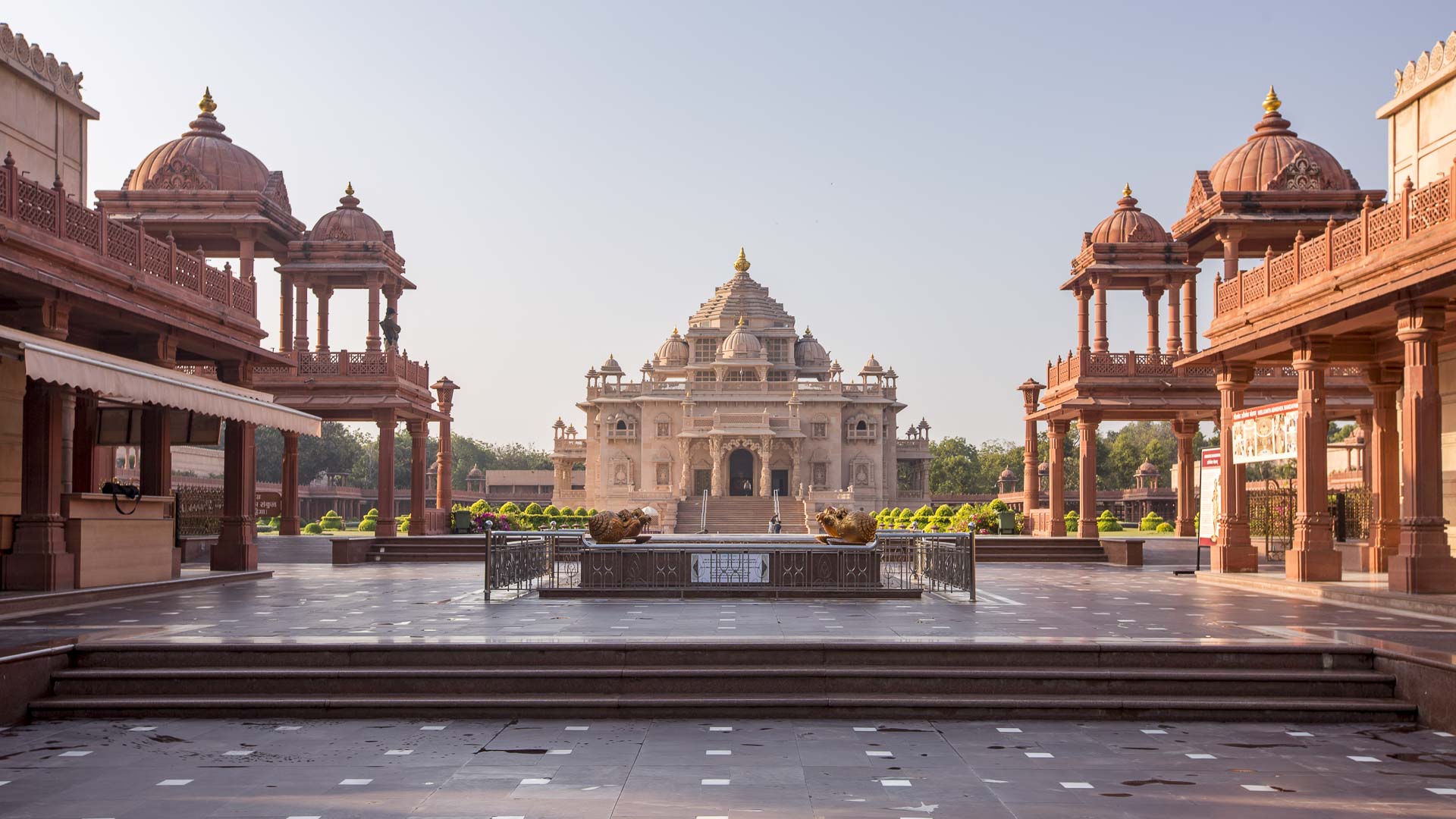


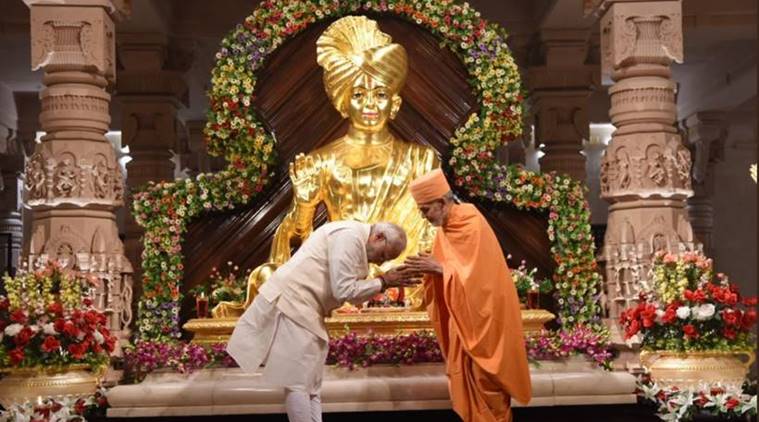
After intense security, one walks on broad walkways through elaborate landscaping with beautiful multicoloured plantings carefully manicured, to the wonderfully carved main temple, built by 1000 artisans using 6000 tonnes of pink sandstone, and opened in 1992. A museum in the basement shows a huge number of Swaminarayan’s personal artifacts. There are 5 exhibition areas explaining the sect but most was in Hindi. At sunset there is a spectacular hi-tech Water Show with fountains, music, a running dialogue in Hindi and a great laser show projected on a ‘water wall’.
It was then a 4 hour, 200 km bus ride on good roads through a desert area, SW to Bhavnagar (pop 510,000). The major industry here is the world’s largest shipbreaking site where thousands of workers dismantle vessels from supertankers down, by hand. In the bus depot, while waiting for a transfer, I was constantly surrounded by 15 staring, young men, all intensely curious and asking questions. It can get a little unnerving after a while. I took the bus another 51 km SW to Palitana and one of Jainism’s holiest pilgrimage sites – Shatrunjaya. It is an incredible hilltop sea of temples built over 900 years.
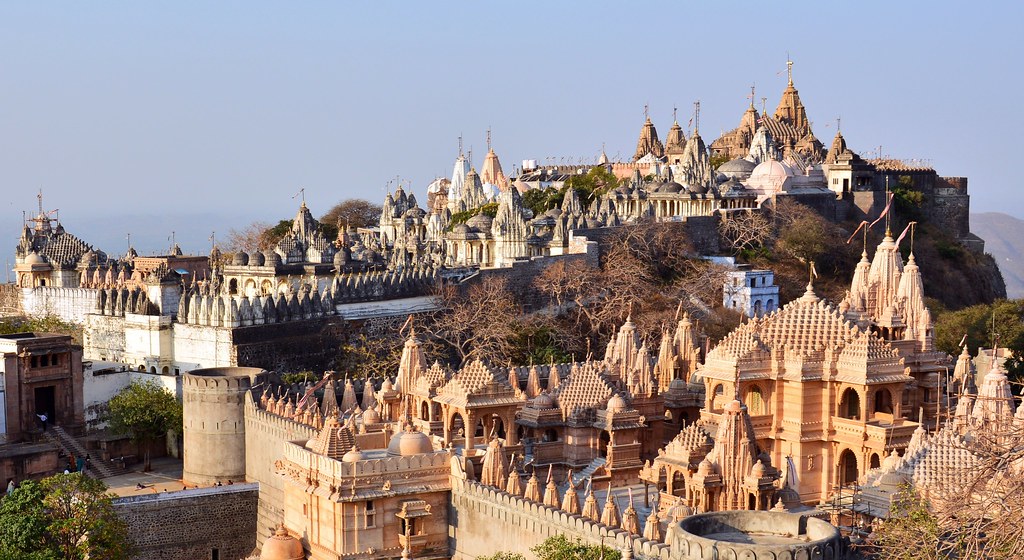
The temples are grouped into large walled enclosures called ‘tunks’, each with a central temple and hundreds of smaller ones. It is a 500m climb up 3300 steps along with hundreds of pilgrims dressed in white robes. Many are carried up in ‘dollies’ usually with only two guys.

The highest tunk with great views, contains a four faced shrine of Adinath, the supreme god of Jainism (a young man told me he is the oldest god known, at least one million years old). This place was empty in contrast to the lower Adinath Temple filled with a frenzy of believers. All the idols are similar looking deities carved from white marble.

On the way down, I walked with a 17-year-old who told me the fundamentals of Jainism – strict vegetarians who also avoid all root vegetables, and kill absolutely nothing. He was in the midst of climbing Shatrunjaya 108 times over 60 days and now was doing it 7 times over 3 days, fasting completely for 2 days! He could not relate to the fact that I was an atheist.
Jainism arose in the 6th century BC as a reaction against the caste constraints and Hindu ritualism. They believe that liberation can be attained by achieving complete purity of the soul. Purity means shedding all matter generated by one’s actions that binds itself to the soul by primarily fasting, meditation, and right conduct (fundamental to this is nonviolence in thought and deed towards any living thing. Monks are severely ascetic but the ‘normal’ Jain maintain a minimum of possessions which include a broom to sweep a path before them to avoid stepping on any living creature, and a cloth tied over their mouth to prevent the accidental inhalation of insects. They are strict lacto-ovo-vegetarians and do not even eat root vegetables as pulling them from the ground risks killing insects. Most Jains live in Gujarat and Mumbai and Jainism only comprises about .4% of the population. This seems small compared to their cultural influence as Jain temples are the most beautiful especially at Mt Abu in Rajasthan. Jains don’t allow menstruating women to enter their temples.
After another 5 hour bus ride over some abysmal roads, I arrived in Diu (pop 22,000), a tiny ex-Portuguese (1535) island, ceded to India only in 1961. Not part of Gujarat, it is administered from Delhi as a territory. It is clean and uncrowded with a quirky charm and serenity. I hoped to recover for a few days. With cheap alcohol, it is frequented by Indians who come here to drink. Only 11×3 km big, it has nice beaches on the south and Diu town on the east end of the island. There are several imposing cathedrals and interesting, quiet, colorful, Portuguese influenced housing in an area of narrow, winding streets. Diu Fort, built in 1535, has a double moat (one tidal) on the land side and must have been impregnable. With huge walls, chapels and many cannon, it was a great place to wander around in for a few hours. I read and relaxed for 3 days.
Ten of us piled into one large motorcycle tuk tuk with all our packs to catch the train 3 hours to Sasan Gir Wildlife Sanctuary. This is the last remaining refuge of the wild Asiatic lion which once roamed from Syria to Burma. Down to 12 animals in 1870, the number has rebounded to 411 at last count. Separated from their African counterparts, the males mane is less luxuriant, and a prominent fold of skin runs the length of the abdomen. It was easy to round-up 10 people in Diu, as everyone wanted to minimize the $40/jeep permit, $10 for the jeep and $3 for the guide. With a one in two chance of seeing lions, I guess we did see one with a sighting on a distant ridge. There were lots of spotted deer, and a few sambal (large deer), along with several peacocks. The sanctuary is in rolling hills and at this time of year is very dry country with small trees. It was a great group and we all stayed at the same guest house gorging on Gujarat thali. After the disappointing safari, everybody went their separate ways and I continued on with two young Swiss women with a similar itinerary to mine. The countryside turned flat with most of the fields fallow waiting for the monsoon for planting.
We changed buses in Junagath (pop 170,00 and best known for its 10,000 step climb up Girnar Hill covered in Jain and Hindu temples) to catch another bus 7 hours back to Ahmedabad. Up early we caught an early bus north to Modhera and its beautiful Sun Temple. It is designed so that the dawn sun shines on the image of Surya, the sun-god, during the equinox. The temple exterior is intricately carved with demons and deities, 12 different monthly manifestations of Surya, and many Kama Sutra scenes (lots of variations on oral sex here). The temple is fronted by the Surya Kund, a rectangular step well with over 100 shrines, resembling a sunken art gallery.
Another bus took us to Patan, Gujarat’s capital before it was moved to Ahmedabad in 1411. The only sign of its former glory is the Rani-ki-Vav, an astoundingly beautiful step well.


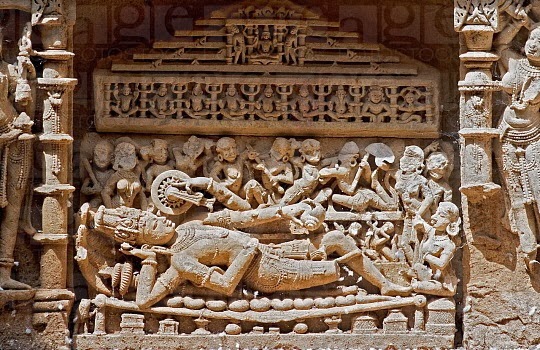
Built in 1063, it is the oldest and finest step well in Gujarat and is remarkably well-preserved. Protected by centuries of silt, it was excavated between the 1960’s and 1980’s. It is 64 x 20 m and 24 m deep. Steps lead down through multiple levels with lines of carved pillars and over 800 sculptures, mostly on Vishnu-avatar themes. The sculptures and carved windows on the lowest levels were in perfect condition.
It was then another two buses and 5 hours to Mt Abu in Rajasthan. We were on 6 different buses during the day and stopped in some out-of-the-way towns not used to Westerners. At one we were surrounded by over a 100 staring Indians, from little kids to turbaned elders. Despite the poor English, there seems to always be some helpful Indian who helps find the right bus. Government bus stands are difficult to navigate – all signs are in Hindi and platforms impossible to figure out.
RAJASTHAN STATE
The entire state (pop 69 million) is definitely on the tourist trail with its fabulous forts and lavish palaces in a mostly desert environment. As Gujarat is alcohol free, it is a popular holiday spot for Indians. Mt Abu (pop 22,000, elevation 1200 m), Rajasthan’s only hill station, sits among green forests on the state’s highest mountain close to the Gujarat border. The mountain is of great spiritual importance for both Hindus and Jains with 80 temples and shrines. The real star and not to be missed Jain temple, is Delwara, built between 400 and 1000 years ago. With easily the best carving, all in marble, in India, the artisans were paid by the amount of dust they collected, encouraging them to carve ever more intricately. It is impossible to figure out how the carving was done without power tools – a Dremel would have been a great help here. Two of the five temples have dizzyingly intense carving. Vimal Vasahi was started in 1031 and took 1500 masons and 1200 labourers 14 years to build.

Outside is the House of Elephants, featuring a procession of marble elephants that carried the marble to the site.
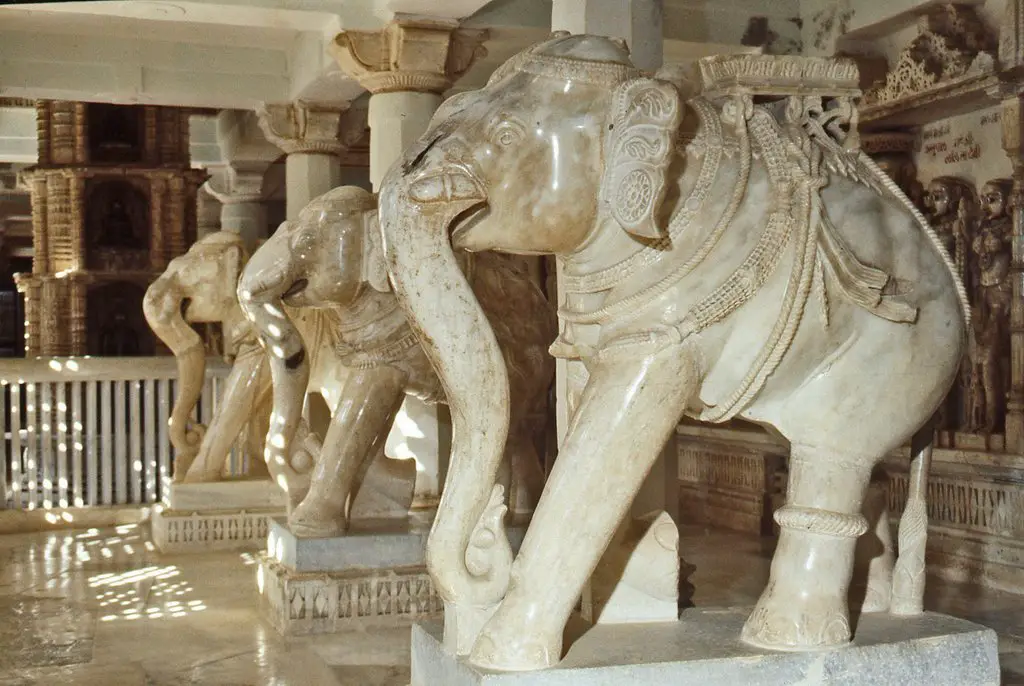
Inside, a forest of beautifully carved pillars surrounds the central shrine to Adinath, the main Jain god. The Luna Vasahi Temple is dedicated to Neminath, the 22nd leader, and was built in 1230 by two brothers.
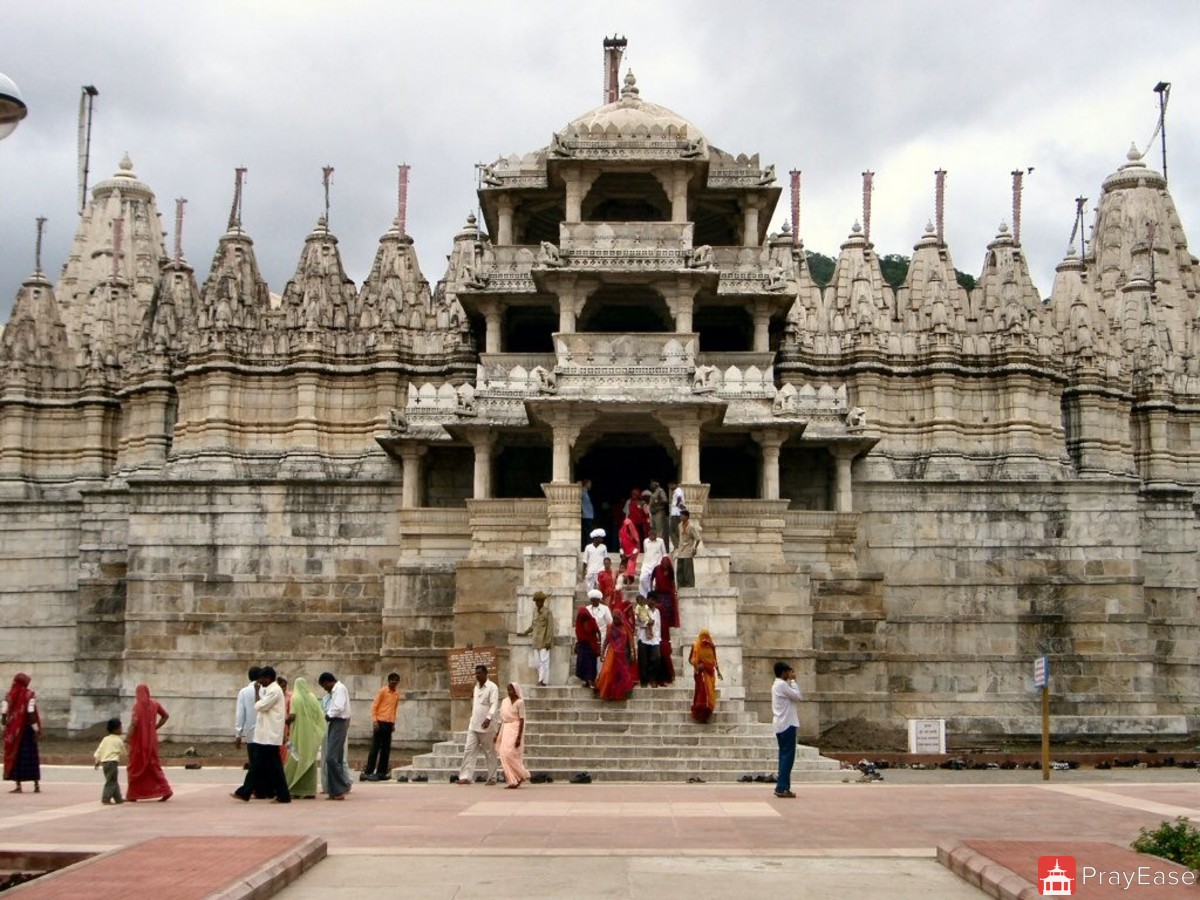
The marble carving here took 2500 workers 15 years to create. Noted for its intricacy and delicacy, the marble almost becomes transparent and it is hard to believe that this huge lace-like filigree started as a solid block of marble. The ceilings were spectacular.

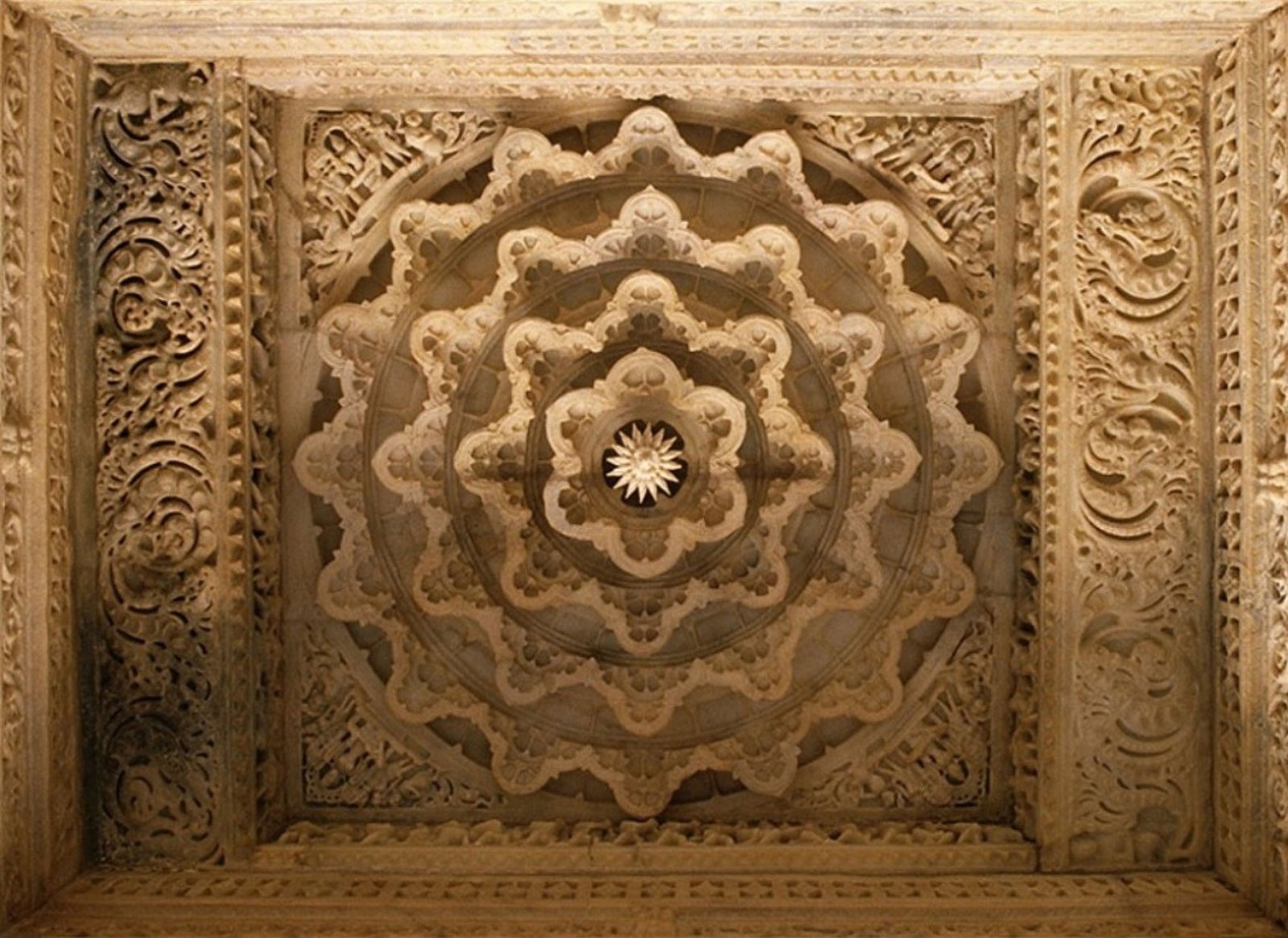
We then climbed up to a Hindu temple built into caves on the mountainside and then climbed the mountain behind for world-class views of the whole town. Descending down to the lake, we walked around the shore and climbed up to Sunset Point for views down to the plains spread out below. At our hotel was an elderly English couple who were birders. They travel all over the world and only go to see birds. His ‘bird count’ was now exactly 6,231. They lugged around a large spotting scope on a tripod. Everyone follows their own path.
While the women went to the beauty parlour, I parked myself in a chair on the edge of a big square that was being covered in cement. Of the 15 man crew (we would have only had one cement truck and a couple of finishers), 8 were involved in making the cement. Six women loaded and carried in large metal pans the sand and gravel. One guy added the cement and one was in charge of water and judging the mix. Two guys wheel barrowed it and two roughly levelled it. One used a vibrator, one finished it and one guy supervised the whole process. Like all work here, everything is very labor intensive. Women seem to do most of the heavy work all while dressed in attractive saris. Many men seem to only sit around and watch the world move by. They also seem to play a lot of rummy.
A five-hour bus east switchbacked down the mountain, across flat plains and then into country with rocky low hills, and took us to Udaipur (pop. 390,000). Built on the shore of Lake Picola, it is surrounded by ridges and hills stretching away in every direction. Once described as the most romantic city in India, that description is wearing thin with modern India’s chaotic traffic on the countless narrow, crooked streets originally made for people and donkeys. Founded in 1568, the city was moved here to deal with repeated Mughal invaders. The 1400 year old Mewar dynasty here is the world’s oldest monarchy, and the present leader is #74. The City Palace complex extends nearly 1 km along the lakes southern shore.
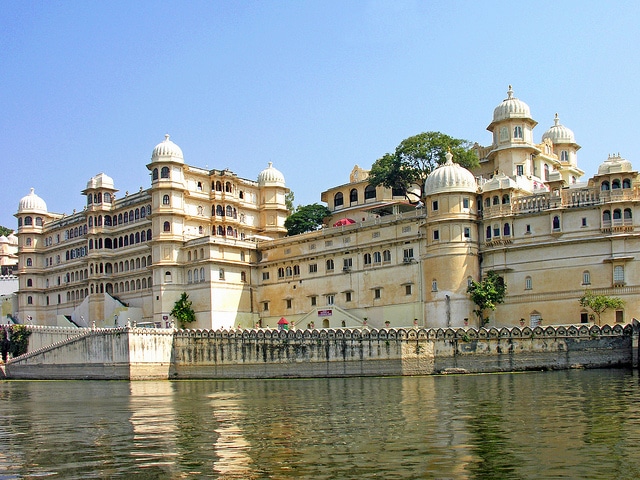

With balconies, towers and cupolas towering over the lake, it is Rajasthans largest palace. Originally the maharanas were weighed eight times and their weight in gold was distributed to the lucky locals. The main part of the palace is open as a museum with a conglomeration of rooms extravagantly decorated and full of artifacts. The Crystal Gallery showcases a complete household of crystal ordered from F&C Osler & Co in England in 1877, but forgotten and packed up in boxes for 110 years. The extraordinary, extravagant collection includes crystal chairs, sofas, tables, and beds and a complete set of dishes. It is displayed in a gallery above the grand Durbar Hall, one of India’s vastest and most lavish royal reception halls. The three crystal chandeliers each weigh 1000 kilograms.
In the evening, I attended a multicultural show with great folk dancing and a puppet show. A dancer balanced 10 pots on her head. Udaipur is a major marble centre. Hundreds of businesses line the highway, with their front yards full of giant sheets. The James Bond movie “Octopussy” was filmed here and a palace, now a hotel, in the middle of the lake was seen in the movie.
On my second day, I took a full day tour north to Kumbhalgarh, a fantastic remote fort 80 km north. The drive was through rocky hilly country and some rugged low mountains covered in cactus. Dry stone walls are everywhere. 1100 m above sea level, it has endless views across mountains and plains.

Used by the Mewar kings from Udaipur during times of danger, it was only taken once in its entire history by a combined force of three armies, and then only for two days. The forts thick walls stretch for about 36 km, and are wide enough in some places for 8 horses to ride abreast. They enclose 360 temples, some dating to the 2nd century BC, as well as palaces, gardens, step wells and 700 cannon bunkers.

The tour continued on to Ranakpur, one of India’s biggest and most important Jain temple complexes. The main temple, the Chaumukha Mandir, is dedicated to Adinath, the first Jain leader.


The temple is a complicated series of 29 halls, 80 domes and 1444 individually engraved pillars. Some of the huge domes have great carving but the intricacy does not match the Jain temple at Mt Abu.
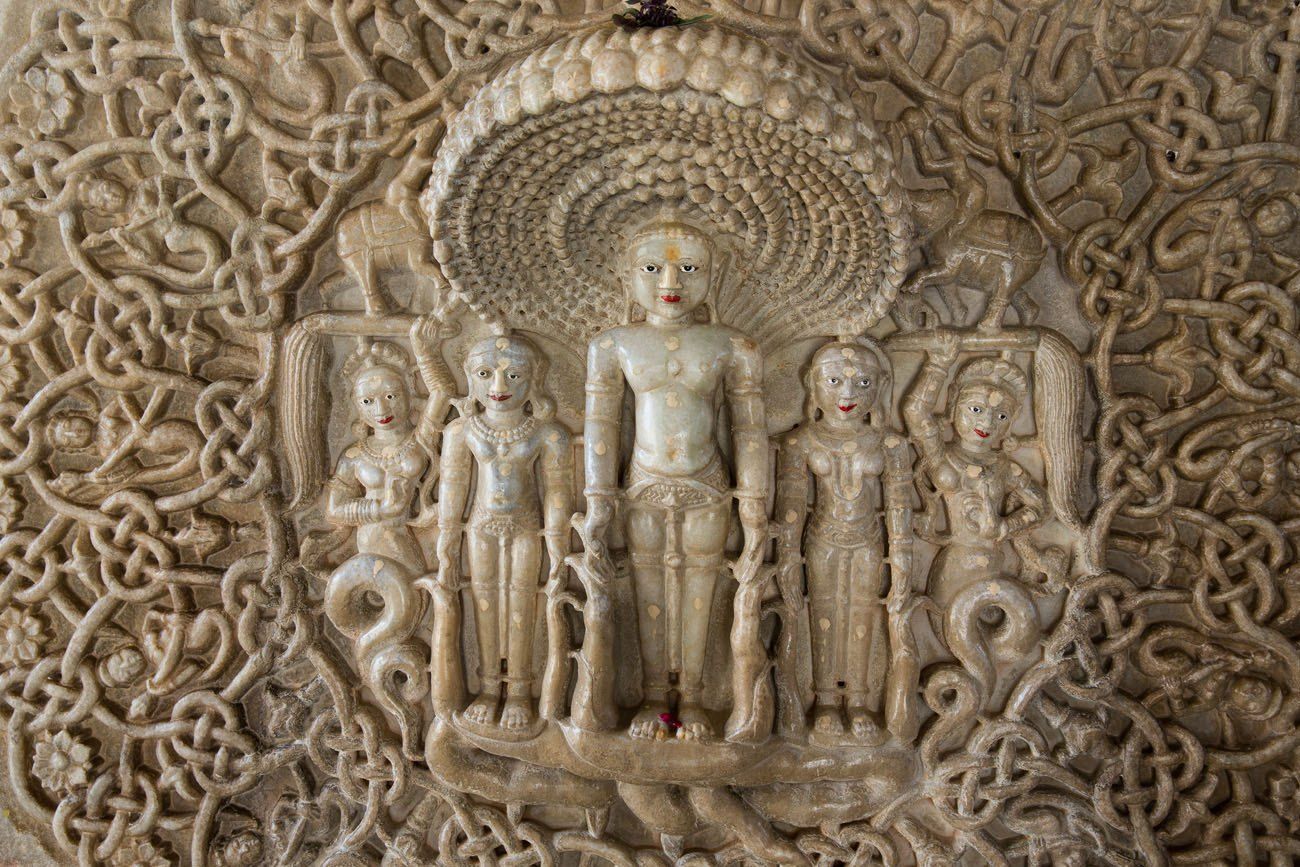

Scores of black-faced monkeys with long tails lined the narrow roads. Most older men wear brightly coloured turbans and many of the older women have tattoos – long lines of blue geometric designs on their hands and arms. Their jewelry is extravagant with huge loops for nose rings attached to long chains. Their earrings likewise are connected to chains that encircle their ears. It is easy to see where all the trends in western jewelry originated – multiple ear piercings, nose rings, toe rings, and bangles. Even though the temperatures are very comfortable, Indians wear heavy jackets, touques. or camouflage ear protectors to ward off the cold.
Another gruelling 9-hour bus east on disastrous roads brought us to Bundi (pop. 90,000), another place on the tourist trail. The city is dominated by the fantastical Bundi Palace of faded parchment cupolas and loggias rising from the hillside above town. The palace is known for its fading turquoise-and-gold murals. Towering above the palace is the 1354 Taragarh Fort with immense walls covering the ridges. Obviously, war was a recurring problem in all these cities and one marvels at the huge palaces and forts built centuries ago requiring huge manpower.
I have been traveling most recently on government buses that mainly run only in the daytime. Usually there are no other westerners. The buses are little different from old school buses and have uncomfortable, non-reclining seats. Luggage is stored inside and doesn’t fit in the small overhead racks or under the seats. As the bus fills up, and your pack must be moved off a seat, there are huge problems of where to put it on a long ride.
Since Gujarat, there have actually been ticket counters to get tickets ahead and find out the platform the bus is leaving from. Otherwise it is a mindless search to find the right bus. All signs are in Hindi. Buses rarely get over 50 km/hr on the bone rattling roads. Even though India is supposed to have the most traffic fatalities in the world, we see few accidents. There would be many more if speeds would be greater. Speed bumps are everywhere. It is not unusual to have vehicles moving the wrong way on divided highways – this saves time by not having to go a long ways to turn around. The many rivers are bone dry and wide in the very flat terrain.
After only one night in Bundi, I continued on to atmospheric (if you can call any of India that) Pushkar (pop. 15,000), 5 hours north. On the trip there, large trucks were moving gigantic metal tubes and power lines had to be lifted by guys using long bamboo poles. Pushkar is a prominent Hindu pilgrimage town. The town, set in a valley surrounded by low mountains, curls around a holy lake with 52 bathing ghats and 400 milky-blue temples surrounding it. One has to remove your shoes to go down to the ghats and thus wade through all the shit from the thousands of pigeons. This is wedding season in India and music blares from parties till early in the morning. Large bands of black-faced monkeys and macaques roam the roof tops. If one leaves the door to your room open, they come in and steal all the fruit. Small carts loaded with loudspeakers parade around town with the ear-splitting music accompanying groups of frenzied dancers. These are common elsewhere but here there is also a huge generator trailing the procession supplying power to elaborate electric lights carried by women surrounding the procession. The result, in Pushkar, is a muddle of religious and tourist scenes. The main street is one long bazaar, selling everything, but especially clothing for tourists and the mailing centres are full of tourists sending large boxes home. All the western women wear long Indian dresses or baggy pants. The food has a definite western flavour with falafel and humus with vegetables in a roll-up being very popular. Stores sell ‘special lassies’ (a lassie is a yoghurt concoction with fruit), that are supposedly laced with marijuana, but I didn’t feel anything. Just one more way to charge 4X what something is worth.
One gets tired of Indian food. With hundreds of dishes, they are often a variant of curry. I have gustatory hyperhydrosis, a genetic condition that causes me to sweat profusely with hot food. I love the food but get tired of the uncomfortable sweat. There was a music festival on for 4 days while I was there and I went to one of the night shows with great Sufi music. A thunderstorm struck and we were able to use a conference centre to see the rest of the show. Rain here causes a real mess – the cow shit liquified and mixes with all the dirt creating a walking nightmare. I walked one hour up to the Saraswati temple on a small local mountain for great views of the town and surrounding countryside. On the way up, I talked to an older couple volunteering at an orphanage for HIV orphaned children in Tamil Nadu. They suggested that India was the next big HIV epidemic on the horizon as Indian men visiting prostitutes spread it to their families. The town is famous for its Brahma temple, one of the few such temples in the world as a result of a curse by Brahma’s consort, Saraswati. The holy lake in town is said to have appeared when Brahma (one of the big three gods who was responsible for the creation of the earth) dropped a lotus flower.
After 4 days in one place (which is unusually long for me), I moved on to Jodhpur (pop 550,000), about 6 hours by bus west. It is famous for the magnificent palace and fort, Mehrangarh, financed from profits built on opium, copper, sandalwood and dates. Built in 1459 on a perpendicular rocky hill 120m above the city, its battlements rise another 6-36m.

After going through 3 massive gates, one encounters the small hand prints of royal widows who threw themselves on their maharaja’ funeral pyres – the last to do so was in 1843. The museum is situated around several large courtyards surrounded by palaces covered in carved sandstone. All the windows are unique latticed stone, all so finely carved that it looks more like sandalwood than sandstone. These jali windows (there are 250 different designs) allow the women of the court to watch all the goings-on in the courtyards without being seen.


Lying at its feet is the old city surrounded by a 10km long wall. Known as the ‘Blue City’, many of the 4-5 story houses are painted blue, in a tangle of winding medieval streets, which never seem to lead where you expect them to. Unfortunately, I found the huge amount of garbage, along with the scented sewers running along side the streets, unpleasant and couldn’t wait to leave. India can be ‘atmospheric’ but this is not the romantic kind of atmosphere one is looking for.
Before catching the bus, I walked out to Jaswant Thada, a milky white marble memorial to one of their leaders. Situated above a small lake, it is an array of whimsical domes in an unusually peaceful spot. Modern Jodhpur stretches well beyond the old city walls and is typical India.
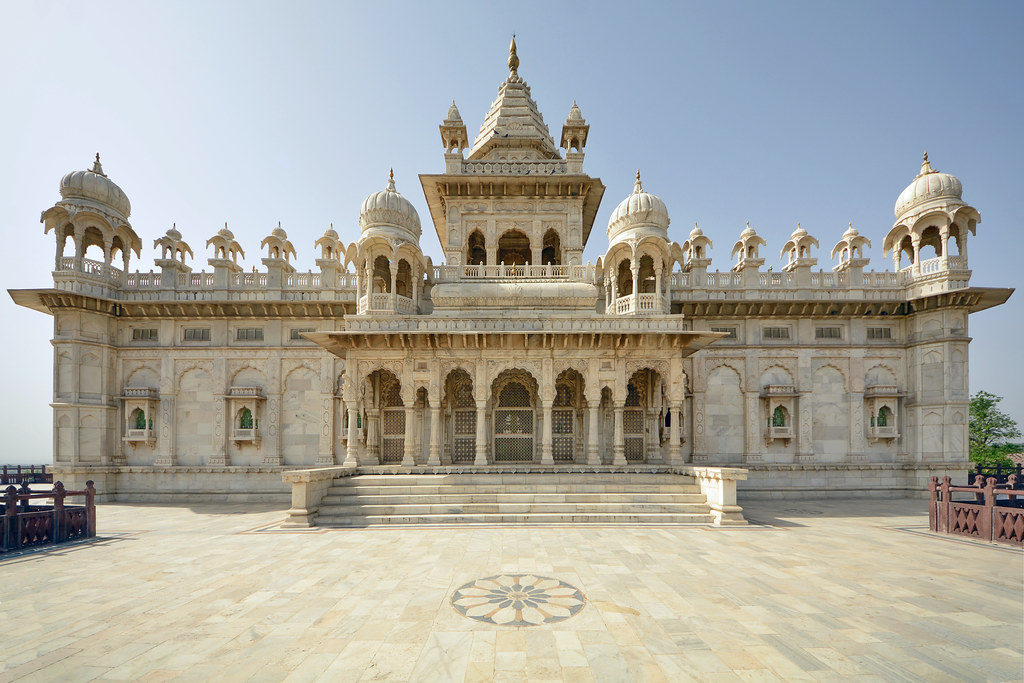
During this time of the year is the six-week long Kumbh Mela, held every 12 years at four different locations across central and northern India.

This is big, very big, and is the largest religious congregation on the planet, attracting tens of millions of Hindu pilgrims, including nagas or naked sadhus from radical Hindu monastic orders. Everyone experiences the electrifying sensation of mass belief and to take a ceremonial dip in the sacred Ganges, Shipra or Godavari Rivers at Allahabad, Haridwar, Nasik and Ujjain. There are auspicious bathing dates, normally six. At this years event, 36 people died when confusion resulted in a mass stampede at a railway depot. I talked to a woman who went. It was apparently absolutely crazy. When they tried to get off the train they were on, the corridor was so packed that the emergency window of the car had to be broken for them to disembark.
Another 6 hour bus ride east took me to Jaisalmer (pop. 60,000), a relatively nice small city without the usual chaos. It is known as the Golden City as virtually everything is made from a honey coloured sandstone. In the 16th century, it prospered from its strategic position on the camel-train routes between India and Central Asia, declined significantly with the coming of trains and sea trade, but revived with the India/Pakistan wars. The town is dominated by the Jaisalmer Fort, an imposing, massive sandcastle rising from the sandy plains and founded in 1156.


It is one of the few forts in the world that is still inhabited. Filled with shops, hotels, restaurants, temples and about 3000 Indians, it is an atmospheric place to walk around through the narrow, twisting streets and intricately carved house fronts. One enters through four massive gates and then zigzags to the upper part to enter a large square surrounded by the former ruler’s seven story palace, now a worthwhile museum. Down one lane is a maze-like, interconnected treasure trove of Jain Temples (admission $3), most dating from the 1500’s. The intricate carving, so much a part of Jain temples, is almost as good as Mt. Abu or Ranakpur but in soft warm sandstone, not marble. Priests are constantly asking for donations.
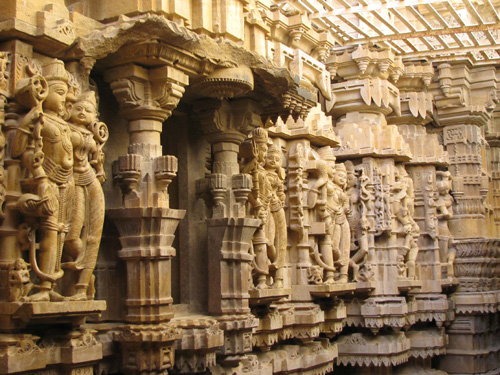
Away from the temple, it is possible to climb up onto the walls, or eat in the many restaurants, for panoramic views. Ninety-nine bastions form part of the walls. The fort is surrounded by a maze of narrow streets especially in the old town to the north. Every house seems to have some intricate carving especially in the balconies and around the windows. The carving reaches its zenith in several large havelis with gorgeously carved stone doorways, jali (carved lattice over windows) screens, balconies and turrets. The biggest is Patwa-ki-Haveli with five sections of intricate stonework like honey colored lace. In the nearby square was a film crew shooting a man with the longest mustache in India at 4′ 10″. His father held the Guinness (spelt Gniess on the poster) World Record mustache of 7′ 10″. Nathmal-ki-Haveli also has an extraordinary exterior dripping with carvings. Gadi Sagar is a 14th century tank that looks more like a lake. Up to 1965, it was the city’s water supply, and is surrounded by many small temples and ghats. Before the monsoon, it can almost dry up and it was quite low in mid February. The large catfish population swarms in a writhing mass to the shore when the locals feed them bread crumbs. I stayed at the Fort View hotel, right under the north side of the fort, and loved getting up at dawn to sit alone in the roof top restaurant and read with a marvelous view. Much English is very stilted. One amusing sign on the outside of a toilet said “Toilet for Especially Able Persons”!!. A store selling intricately sewn quilts said “Viagra Unnecessary – Magic Quilt”.
Jaisalmer is famous for its camel safaris and I took a two-day/one night safari, about the right duration. With six French people, who are famous for never speaking English, I had a chance to catch up on my reading. We rode on the camels for about six hours total and it was quite nice as they are a little smoother than horses but without stirrups to help cushion the ride. It is a long way up to fall.
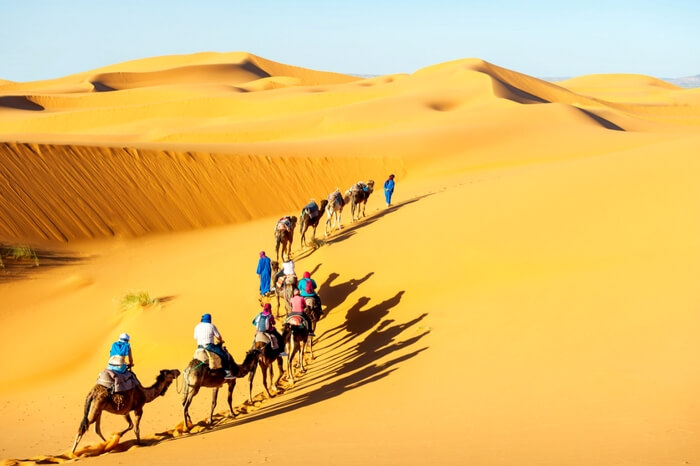
The desert had a few large trees, smaller bushes with large waxy leaves and a lot of brush. Several dry fallow fields were waiting for the monsoon for sowing. There were only small scattered sand dune areas. It was a lovely night sleeping under the stars on the dunes. Our guides were two in their twenties, a 15 and two 12 year olds, all Muslim. They lived in a village without electricity and none had ever gone to school and thus were completely illiterate. Their English, learned from tourists, was surprisingly good. On the second day, one of the older guys rode with me on my camel, and I had a chance to talk a lot. He had never talked to his wife before their marriage and planned on only two or three kids. His dream was to own a camel but with a salary of about $40/month and the cost of a camel at $500, it was a dream unlikely to be fulfilled. We passed several elaborate resorts with nice wall tent accommodation. These are mostly used by Indians who would not want to go on long camel rides nor sleep out in the open. A village of “gypsies” consisting of minimal tarp housing, provided the entertainment of dancing and singing for these resorts (these people were considerably less well off than our impoverished guides). Several wind farms were in the distance.
I decided to attend the 3 day, famous Desert Festival in Jaisalmer that started on February 23 after my camel safari. The festival began with a fantastic parade that wound through the narrow streets to the stadium where all the events are held. One of the highlights was the Indian Army Camel Troop.

There were 30 incredibly decorated camels ridden by decked out officers with spears, turbans, and over the top mustaches, followed by a full band riding similar camels. The band had large horns, trumpets, clarinets and drums and the camels were big, very healthy males (only male camels are ridden). Another group of enthusiastic drummers escorted six men dressed in drag who put on a great dance show. These are actually hijras, India’s most visible nonheterosexual group.
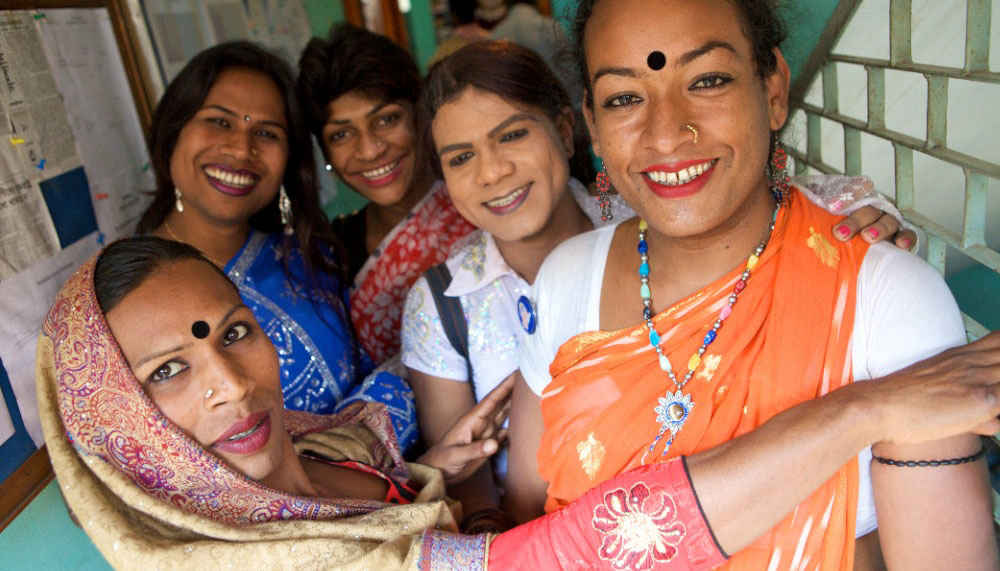
They are a caste of transvestites and eunuchs who dress in women’s clothing. Most are probably gay which has long been frowned upon to live openly in India and hijras get around this by becoming, in effect, a third sex of sorts. They work mainly as uninvited entertainers at weddings and celebrations of the birth of male children, and possibly as prostitutes. Several men dressed in all their finery (white outfits, swords, great jewelry including large earrings with chains that went around the entire ear) sported over the top beards and mustaches. Many women carrying pots filled with fruit on their heads were also in the parade. In the stadium, I stood directly behind the VIPs (including the governor of Rajasthan), but with a crush of Indians surrounding me. There was a turban tying contest for Indians and foreigners, and a mustache contest for guys with exuberant facial hair. The Mr. Desert competition surprisingly involved young kids with fake mustaches. The next days itinerary consisted of a camel decorating contest (the 3 contestants looked identical except for their turbans, swords and mustaches), tug of wars pitting Indians versus foreigners with men and women contestants (the foreigners won both), a race where men stripped down to their underwear had to run to their sandals, get on their dhotis, tie a turban, and saddle and mount their camels, another race carrying big water jugs on their heads (Indian and foreigner women), and finally camel polo played with a soccer ball (camels are not very agile and it was not very exciting).

Some observances about Jaisalmer and India in general. A pack of stray dogs live in the square in front of the hotel. They sleep all day and then bark throughout the night. I saw a dog eating cow shit. In one town in India, people feeding dogs were attacked by other townspeople. When talking to the owner of the hotel, there was absolutely no method of dealing with the dogs other than to throw stones at them. The small square is swept every morning producing an incredible pile of garbage. A herd of cows also live in the square eating all the garbage. They occasionally are fast enough to steal vegetables off the street stalls. I passed a group of blacksmiths sharpening railway spikes. The forge was fueled with sticks and the fan was a guy hand cranking a large bicycle wheel. The open sewers often fill up with garbage and they are cleaned out by hand. It is amazing the equanimity with which these people do these horrific jobs. I bought a book (White Tiger) at a book store. Wrapped in plastic and costing only $5.50, it was obviously a photocopy. The intensity of the print changed from page to page and the print was often not lined up on the page. When the photocopy actually left letters or words out, they had even hand written in the deletion. This is a very common practice for many things in India but it was one-third the price of the Kindle edition. Occasionally one sees Indians reading newspapers but I have never seen an Indian reading a book (whereas foreigners are constantly reading on buses etc).
Jaisalmer has 2 German Bakeries like many other towns and they produce delicious pies and cakes. The honey nut pie and apple crumble were delicious. My nice small hotel room with a bathroom and hot shower cost $5.70/night. Many people in India have a withered leg and walk with a dramatic limp – this is always the result of polio. The last case of polio in India apparently occurred 2 years ago thanks to an aggressive vaccination program sponsored by Rotary International. Old women are the most common beggar in India (presume they have no family to look after them), followed by children and young women with babies on their hips and then people with amputations and leprosy deformities. I am uncertain how to deal with all these but most tourists give nothing whereas it is not uncommon for Indians to put a few rupees in their cups. Children should never be given money as it encourages begging behavior. Children are often controlled by adults and abused. It is not uncommon to see motorcycle graveyards – huge numbers of dusty motorcycles still with their license plates lined up in big rows.
I decided to not see the last day of the festival and caught the 6 AM bus 7 hours NE to Bikaner (pop 500,000). Founded in 1455, the ruling Rathores built a huge fort between 1589 and 1593. It was never breached as the rulers wisely formed alliances with the invading Mughals and British. Their rulers were uncommonly wise, developed schools, hospitals, a huge canal to deliver water to this parched part of India and in 1886, were the first to have electricity in India. Junagarh, the impressive fort was quite worthwhile because of the intricate carved balcony windows and jali screens and intricate painted interiors.

It is a symphony of gold paint, murals, sandalwood, ivory, mirrors, niches, and stained glass. The huge weapon displays included a great collection of old rifles.
I stayed in the best room since coming to India, all for less than $11. Spacious and spotlessly clean, there were nice furnishings, marble floors, top and bottoms sheets, a TV, toilet paper, and a towel (all these are usually absent in budget rooms). At our hotel was a tour group mostly Canadians from Quebec. They are ferried around in a big van, taken from attraction to attraction, and have all their hotels and meals prearranged. I doubt that they gain any authentic perspective of a country, certainly not India. This method of travel is not appealing to me. It may be a necessary way to travel if one has a limited time for a holiday because of work and want to pack in as much as possible. Bikaner is also a great place to take camel safaris without all the hassle factor of Jaisalmer. Camels form most of the horse power here often pulling small carts with large rubber tires and loaded with impossibly large loads.
Bikaner’s main attraction is actually Karni Mata Temple, 30 kms south of town. Karni Mata was 14th-century incarnation of Durga, who in a disagreement with Yama, the god of death, decreed that all members of Yamas family would be reincarnated as rats. Extraordinary even by Hindu standards, the mass of holy rodents running around the temple is not for the squeamish. It’s considered auspicious to have one run across your feet and sighting one of the white rats (I did) also augurs well for your spiritual progress. The rats were fed grain and milk from huge bowls and you can only imagine how many there were when rats are allowed to produce at an unlimited rate.
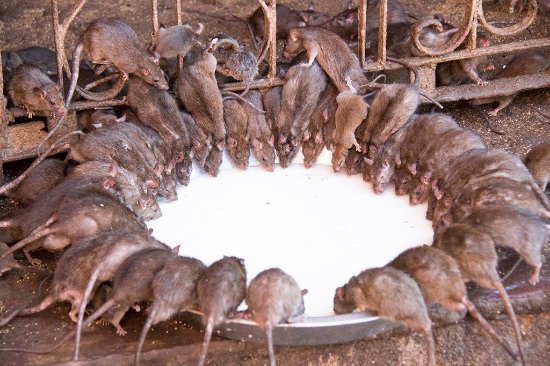
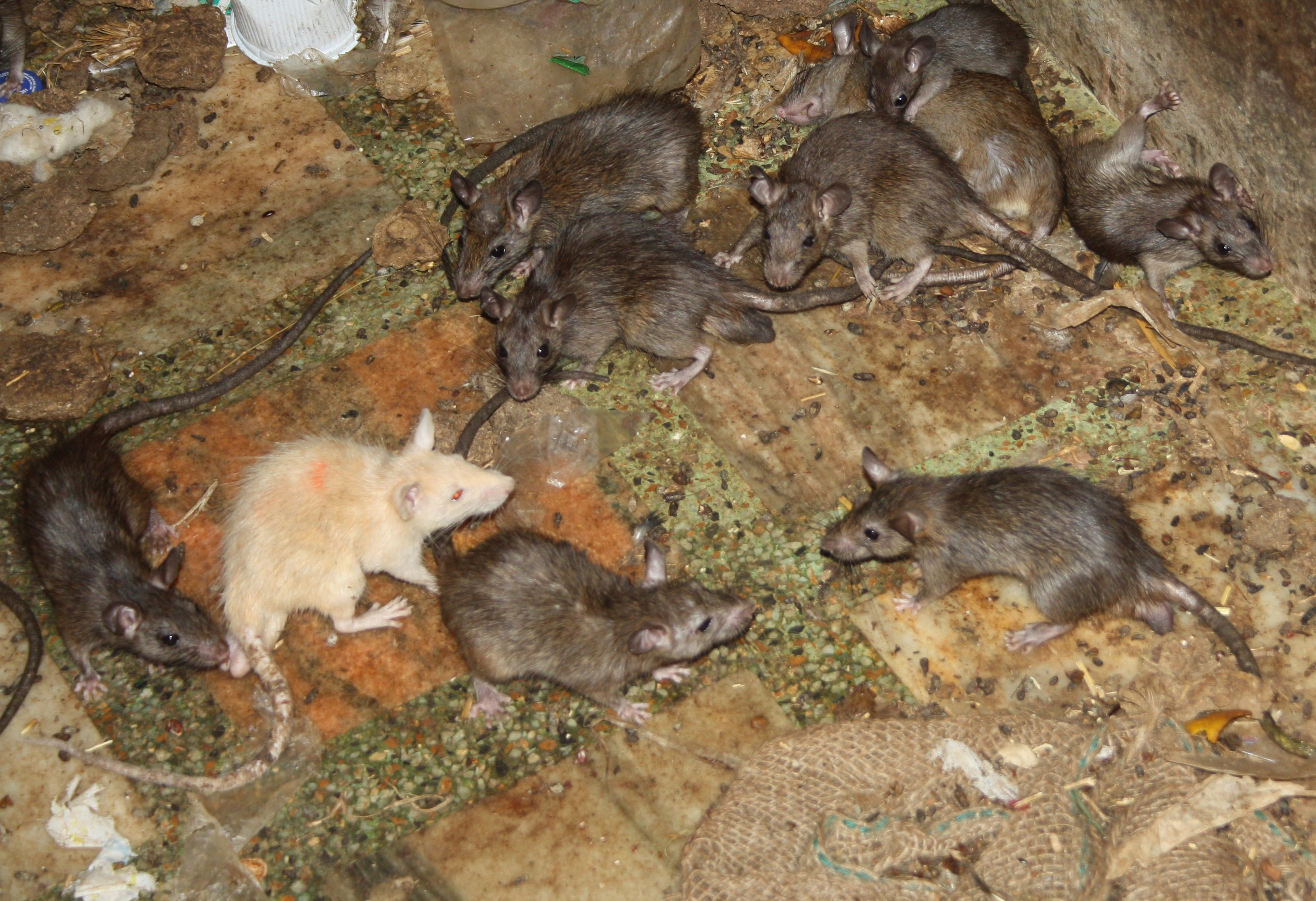
F***ing crazy. One had to remove your shoes to enter and it was decidedly unpleasant to walk around with all the rat shit and grain on the floor.
India has all their animals upside down. The cow is top dog, with snakes, monkeys and rats next and dogs at the bottom of the heap. To be reincarnated as a dog is the worst. Despite all this holy reverence, it seems that they abuse animals. People who can’t afford to feed their animals simply let them run loose and that is why garbage is a mainstay of food for cattle, goats, and dogs. Outside of Bikaner, next to a normal garbage dump, hundreds of dead cows, most from intestinal obstructions from eating plastic, were deposited. The rotting bodies were being fed upon by packs of dogs! Holy cow! I heard my first rooster the one night I stayed in Bikaner. Chickens in India are not free range like in so many third world countries. The only chickens I have ever seen are sickly looking, thin, white, and hen-pecked birds kept in small cages. It is not uncommon to see chickens carried on motorcycles – four groups of 10 or so live birds with their feet trussed together hanging from the handlebars and back racks. It makes one question eating chicken in India. However this is almost always the only form of meat available in this predominately vegetarian country where cows and pork are never consumed.